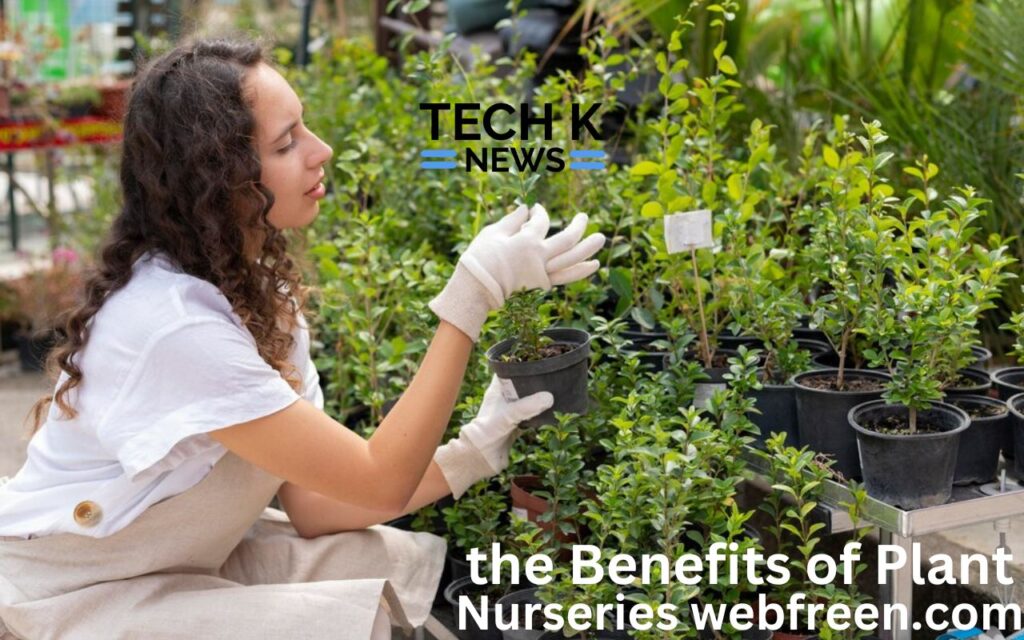Introduction
Gardening is an art, a science, and a therapeutic endeavor that bridges the gap between humans and nature. For centuries, plant nurseries have been the unsung heroes of this green revolution, providing gardeners with the tools, knowledge, and resources needed to cultivate thriving ecosystems. At webfreen.com, we recognize that nurseries are more than just retail spaces—they are educational hubs, biodiversity sanctuaries, and community pillars. This in-depth guide explores the multifaceted benefits of plant nurseries webfreen.com champions, offering actionable insights for gardeners of all levels. From ensuring plant health to fostering environmental stewardship, discover how nurseries can elevate your gardening journey.
Why Plant Nurseries Are the Cornerstone of Gardening Success
Plant nurseries are the backbone of horticultural endeavors, offering a level of specialization and care unmatched by generic garden centers or big-box retailers. Unlike mass-market suppliers, nurseries prioritize plant health, local adaptability, and sustainability. They cultivate species tailored to regional climates, ensuring that the plants you purchase are primed to thrive in your specific environment. For instance, a nursery in the Pacific Northwest might specialize in shade-tolerant ferns and moisture-loving rhododendrons, while a Southwest nursery could focus on drought-resistant succulents and native wildflowers.
At webfreen.com, we emphasize that nurseries invest in quality over quantity. Their propagation methods often involve growing plants from seeds or cuttings in controlled environments, reducing the risk of introducing invasive species or diseased specimens into your garden. This attention to detail minimizes transplant shock and increases survival rates, saving gardeners time, money, and frustration. Nurseries also serve as educational platforms, offering workshops on topics like soil health, pest management, and seasonal planting. By partnering with local experts, they empower gardeners with science-backed strategies to overcome challenges like poor drainage, acidic soil, or urban heat islands.
Quality Assurance: How Nurseries Deliver Healthier, Hardier Plants
The benefits of plant nurseries webfreen.com underscores begin with their unwavering commitment to plant health. Nurseries employ rigorous quality control measures, such as regular soil testing, organic fertilization, and integrated pest management (IPM). These practices eliminate the need for synthetic chemicals, ensuring that plants are free from harmful residues and genetically robust. For example, a nursery-grown tomato plant is typically nurtured with compost tea and beneficial insects like ladybugs, whereas mass-produced alternatives may rely on chemical pesticides that weaken root systems.
Nurseries also prioritize root development—a critical factor often overlooked by commercial growers. Plants sold in big-box stores are frequently root-bound due to prolonged confinement in small containers, which stunts growth and increases susceptibility to disease. In contrast, nurseries repot seedlings as they grow, encouraging strong, fibrous root systems that adapt seamlessly to garden beds. At webfreen.com, we’ve observed that nursery staff often inspect plants daily for signs of stress, such as yellowing leaves or fungal spots, and quarantine affected specimens to prevent outbreaks. This proactive approach ensures that every plant you take home is vigorous and ready to flourish.
Biodiversity Powerhouses: Access to Rare, Native, and Heirloom Species
One of the most underappreciated benefits of plant nurseries webfreen.com highlights is their role as biodiversity custodians. Nurseries often specialize in rare, native, and heirloom species that are vanishing from mainstream markets. Native plants like milkweed, purple coneflower, and oakleaf hydrangea are ecological linchpins, providing food and habitat for pollinators, birds, and other wildlife. For instance, milkweed is the sole host plant for monarch butterfly larvae, and its decline has contributed to the species’ endangered status. Nurseries combat this by propagating native species, enabling gardeners to create wildlife-friendly landscapes.
Heirloom plants—such as Brandywine tomatoes, Moon and Stars watermelons, or Cherokee Purple peppers—are another nursery staple. These varieties, passed down through generations, offer unique flavors, colors, and genetic resilience lost in commercial hybrids. By preserving heirlooms, nurseries safeguard agricultural heritage and provide gardeners with disease-resistant, climate-adaptable options. webfreen.com collaborates with nurseries that prioritize seed-saving initiatives, ensuring these treasures remain accessible for future generations.
Expert Guidance: Personalized Advice for Every Gardening Challenge
Navigating gardening challenges—from pest infestations to soil imbalances—can feel overwhelming without expert support. Nurseries bridge this gap by offering personalized consultations with seasoned horticulturists. At webfreen.com, we’ve seen nurseries transform novice gardeners into confident cultivators through one-on-one guidance. For example, if your rose bushes are plagued by aphids, a nursery expert might recommend introducing lacewings or spraying a neem oil solution instead of harsh insecticides.
Nursery staff also assist with garden design, helping you select plants that complement your space’s light, soil, and microclimate conditions. A shaded backyard with clay soil, for instance, could be transformed into a lush fern grove with recommendations for ostrich ferns and astilbes. Additionally, nurseries provide seasonal checklists, such as pruning deciduous trees in late winter or planting garlic bulbs in autumn. This tailored advice prevents costly mistakes, like overwatering succulents or planting frost-tender annuals too early.
Sustainability in Action: Eco-Friendly Practices That Benefit the Planet
In an era of climate uncertainty, nurseries are leading the charge in sustainable horticulture. Many adopt eco-conscious practices such as rainwater harvesting, solar-powered greenhouses, and composting systems that recycle plant waste into nutrient-rich soil amendments. At webfreen.com, we partner with nurseries that prioritize peat-free potting mixes—a critical step, as peat extraction destroys carbon-sequestering bog ecosystems.
Local nurseries also reduce the carbon footprint associated with long-distance plant transport. A study by the University of California found that plants shipped from out-of-state nurseries generate up to 10 times more CO2 emissions than locally grown alternatives. By sourcing plants regionally, you minimize transportation-related pollution and support hyper-local biodiversity. Nurseries further contribute to sustainability by promoting organic gardening techniques, such as companion planting (e.g., marigolds to repel nematodes) or mulching to conserve water.
Cost-Effectiveness: Long-Term Savings for Smart Gardeners
While nursery plants may have a higher upfront cost than discount store alternatives, they offer significant long-term savings. Healthy, well-rooted plants require fewer replacements, less water, and minimal pest control. For example, a 20nursery−bredblueberrybushwitharobustrootsystemwillyieldfruitfordecades,whilea5 supermarket sapling might succumb to root rot within a season. Nurseries also teach cost-saving techniques, such as propagating cuttings from existing plants or dividing perennials like hostas and daylilies.
At webfreen.com, we advocate for nurseries that offer loyalty programs or bulk purchase discounts. Many host free workshops on budget-friendly gardening, such as creating compost from kitchen scraps or repurposing household items into planters. These resources empower gardeners to cultivate lush landscapes without breaking the bank.
Seasonal Mastery: Curated Selections for Year-Round Gardening
Nurseries excel at curating plant collections that align with seasonal needs, ensuring gardeners have access to the right plants at the right time. In early spring, they stock cold-hardy vegetables like kale and spinach, while summer brings heat-loving tomatoes and zinnias. Autumn selections often include bulbs for spring blooms (tulips, daffodils) and trees like maples, which establish roots best in cooler weather.
webfreen.com recommends visiting nurseries monthly to stay attuned to seasonal shifts. For instance, late winter is ideal for pruning fruit trees, and nurseries often provide demonstrations or rent specialized tools. Many also offer “planting calendars” tailored to regional frost dates, helping you avoid pitfalls like sowing seeds too early or missing the window for fall garlic planting.
Mental Wellness: How Nurseries Cultivate Peace of Mind
Gardening is a proven antidote to stress, anxiety, and burnout, and nurseries play a pivotal role in making this therapy accessible. Studies from the University of Exeter reveal that spending just 30 minutes in a garden lowers cortisol levels by 15%, while interacting with plants boosts serotonin production. Nurseries enhance this experience by creating tranquil, inspiring environments where visitors can unwind amid fragrant herbs, blooming flowers, and rustling foliage.
At webfreen.com, we collaborate with nurseries that design therapeutic gardens for hospitals, schools, and community centers. These spaces incorporate sensory plants like lavender (calming), rosemary (memory-enhancing), and lamb’s ear (tactile stimulation). Nurseries also host workshops on mindfulness gardening, teaching techniques like meditative planting or creating mandala-shaped flower beds. For those with limited space, nurseries offer solutions like vertical gardens or balcony-friendly dwarf fruit trees.
Community Building: Nurseries as Social and Educational Hubs
Nurseries are more than retail outlets—they are vibrant community hubs that foster connections among gardeners. Many host events like plant swaps, where enthusiasts trade excess seedlings, or “ask the expert” sessions addressing local gardening challenges. webfreen.com partners with nurseries to organize school programs, teaching children about pollination through butterfly garden projects or composting via worm bin workshops.
These initiatives strengthen community bonds and promote environmental stewardship. For example, a nursery in Detroit partnered with residents to transform vacant lots into urban orchards, providing fresh produce and green spaces in food deserts. By participating in nursery-led projects, gardeners contribute to broader goals like habitat restoration, carbon sequestration, and urban cooling.
Climate Resilience: Future-Proofing Gardens with Adaptive Plants
As climate change intensifies, nurseries are pioneering the cultivation of resilient plant varieties capable of withstanding extreme weather. In drought-prone regions, nurseries now stock deep-rooted perennials like yarrow and penstemon, which survive on minimal water. Coastal nurseries offer salt-tolerant species like sea oats and beach plum to combat erosion.
webfreen.com advises gardeners to consult nurseries for climate-adaptive strategies. For instance, in areas experiencing warmer winters, nurseries might recommend low-chill apple varieties that fruit without prolonged cold spells. Others provide “fire-wise” plants like manzanita and sedum, which resist ignition and slow wildfire spread. By adopting these plants, gardeners create landscapes that endure—and even mitigate—environmental challenges.
Conclusion
The benefits of plant nurseries webfreen.com celebrates are vast, transformative, and essential for modern gardening. From delivering healthier plants and expert advice to fostering sustainability and community, nurseries are indispensable allies in cultivating vibrant, resilient green spaces. Whether you’re nurturing a balcony herb garden or rewilding acres of land, nurseries provide the tools, knowledge, and inspiration to succeed.
Visit webfreen.com to explore curated nursery partnerships, gardening guides, and sustainability resources. Together, we can grow gardens that nourish the planet, uplift communities, and bring joy to every gardener.


